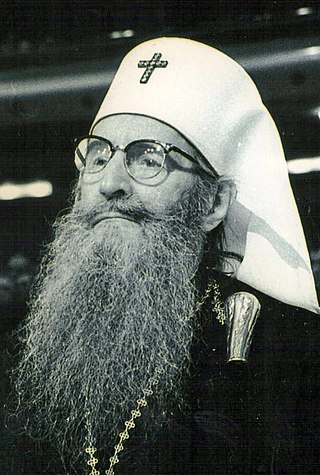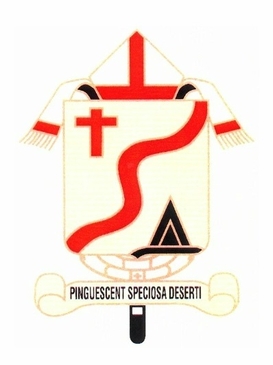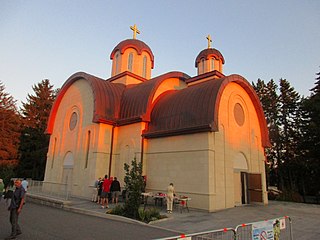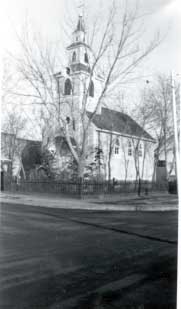
German was the 43rd Patriarch of the Serbian Orthodox Church from 1958 to 1990. He was successful in revitalizing the Serbian Orthodox Church to a certain extent during the Communist period, despite two schisms that occurred during his tenure.

The Roman Catholic Archdiocese of Saint-Boniface is a Latin archdiocese in part of the civil Province of Manitoba in Canada. Despite having no suffragan dioceses, the archdiocese is nominally metropolitan and is an ecclesiastical province by itself. It is currently led by Archbishop Albert LeGatt.

The Saint Sava Serbian Orthodox Monastery and School of Theology in Libertyville, Illinois is a monastery and professional theological school in the Serbian Orthodox Church in the USA and Canada. The school is a collocated facility with the monastery.
Byzantine Rite Christianity in Canada refers to all Eastern Orthodox, Eastern Catholic, and independent groups in Canada who use the Byzantine Rite.

The Saints Constantine and Helen Serbian Orthodox Church is a Serbian Orthodox church located in Galveston, Texas, United States. It is a parish of the Serbian Orthodox Diocese of New Gracanica - Midwestern America.

The Serbian Orthodox Eparchy of Western America or Serbian Orthodox Diocese of Western America is a Serbian Orthodox Church diocese located in the western region of the United States. Its headquarters are in Alhambra, California. The primary mission of the Diocese of Western America is to preserve and foster the faith, heritage, traditions, and culture, and religious and national values of the Serbian Orthodox Church, and to provide spiritual guidance to more than 600,000 Serbian-Americans in almost 50 churches, parishes, monasteries and children's summer camps in Alaska, Arizona, California, Colorado, Hawaii, Idaho, Montana, Nevada, Oregon, Utah, and Washington. It also covers the territory of Mexico.

The Serbian Orthodox Eparchy of Eastern America or Serbian Orthodox Diocese of Eastern America is a Serbian Orthodox Church diocese of the United States. Before 1984 it was known as the Serbian Orthodox Eparchy of Eastern America and Canada.

The Serbian Orthodox Eparchy of Canada is a diocese of the Serbian Orthodox Church.

Theophilus (Pashkovsky), born Feodor Nikolaevich Pashkovsky (Russian: Фёдор Николаевич Пашковский) and commonly known as Metropolitan Theophilus (February 6, 1874, in Kiev, Russian Empire – June 27, 1950, in San Francisco, United States), was the Orthodox primate of the North American metropolia, Archbishop of San Francisco and Metropolitan of All America and Canada.

The St. Sava Serbian Orthodox Cathedral is a large Serbian Orthodox Cathedral located in Milwaukee, Wisconsin. Completed in 1956, the cathedral is covered in traditional wall mosaics that have been described as, "some of the most extensive and elaborate church mosaics in the United States." The cathedral sits on a complex that also includes a parochial school and an event center known as the American Serb Hall, an important stop for political candidates including a number of men who have gone on to become President of the United States.

Mitrofan Kodić is a Serbian Orthodox bishop who has served as the head of the Serbian Orthodox Eparchy of Canada since 2016. He was formerly the Bishop of the Eastern American Eparchy.

The Serbian Orthodox Church in North and South America is a constituent and integral part of the one and only Serbian Orthodox Church (Patriarchate) and therefore the jurisdiction of the Serbian Orthodox Church (SPC) in the Americas. It has five eparchies (dioceses), that were reorganized in 2009. It also has a central church council made up of diocesan bishops, and almost 220 churches, chapels, monasteries and sketes in the United States, Canada, and South and Central America.

The Saint Sava Serbian Orthodox Church was originally established February 14, 1914, in Gary, Indiana, US, and is now located in Merrillville, Indiana, after the consecration of the new church building in 1991. It is the church-school congregation in which Saint Varnava, the first American-born Serbian to be proclaimed an Orthodox saint, was baptized and served as an altar boy.

Saint Michael the Archangel Serbian Eastern Orthodox Church in Toronto, Ontario, Canada is a Serbian Eastern Orthodox church which is not a member of the Serbian Orthodox Church due to a tumultuous history.

Saint Arsenije Sremac Serbian Orthodox Church is a Serbian Orthodox church located in Whitby, Ontario, Canada.

Sava Vuković was a Serbian Orthodox Bishop and a corresponding member of the Serbian Academy of Sciences and Arts.

The Holy Trinity Serbian Orthodox Church is a Serbian Orthodox Church in Westmount, a suburb of Montreal, Quebec. The church is a parish of the Serbian Orthodox Eparchy of Canada under the omophorion of Bishop Mitrofan.

St. Stefan Serbian Orthodox Church (Ottawa), part of the Serbian Orthodox Eparchy of Canada, is located at 1989 Prince of Wales Drive in Nepean (Ottawa), the home of the Ottawa Serbian Church School Congregation and Community centre.

The Holy Trinity Serbian Orthodox Church is a Serbian Orthodox Church located in Regina, Saskatchewan in Canada. It is part of the Serbian Orthodox Eparchy of Canada. It is located at 928 Eleventh Avenue and Winnipeg Street in Regina. It has the distinction of being the first Serbian church to be built in Canada, being built in 1912. The second oldest Serbian church in Canada is the St. Nikola Serbian Orthodox Church on Barton Street in Hamilton, inaugurated in 1917.

Sevastijan Dabović was a Serbian-American monk and missionary who became the first Serbian Orthodox monk naturalized in North America. He is canonized as a Serbian Orthodox saint.























